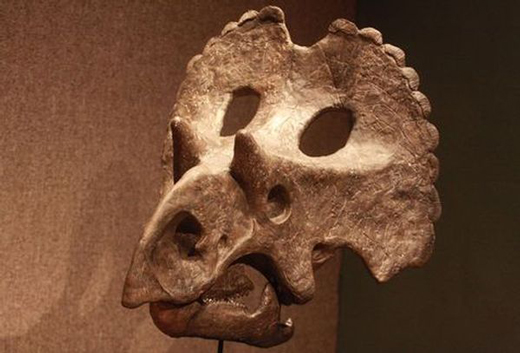Yehuecauhceratops mudei – Mexican Relative of Nasutoceratops
Last week, a new species of North American horned dinosaur was announced. Named Yehuecauhceratops (Y. mudei), at three metres long, it was little more than a third the size of Triceratops, but its discovery, after a ten-year-long exploration of Upper Cretaceous strata of the State of Coahuila (northern Mexico), is still significant, as it once again demonstrates that towards the end of the Age of Dinosaurs much of the ancient land known as Laramidia was home to very distinct populations of prehistoric animals.
Yehuecauhceratops
A Model of the Reconstructed Skull of Yehuecauhceratops
Picture credit: Museo del Desierto, Mexico (The Coahuila Desert Museum)
For articulated replicas of horned dinosaurs and other prehistoric animals: Beasts of the Mesozoic Models and Figures.
Scraps of Bone but a Significant Bump
Fossils found in the Coahuila Desert in 2007 and in 2011 were very fragmentary and the field team from the Coahuila Desert Museum in collaboration with scientists from Germany who had joined them on the expedition, were not sure quite what they had found. It was assumed it was a horned dinosaur, after all, the first horned dinosaur known from Mexico, Coahuilaceratops (named in 2010), had been found in the same area. However, a piece of the head shield showed a small, but significant bump that distinguished the fossils from the chasmosaurine Coahuilaceratops, the frill had a definite look of a centrosaurine.
Pieces of the Head Shield Revealed Unique Morphology – The Fossils Represented a New Species

A small but significant bump on part of the head shield identified this dinosaur as a centrosaurine.
Picture credit: The Journal of South American Earth Sciences
In total, Yehuecauhceratops mudei has been described from a partial and very fragmented skull, a thigh bone, elements of the hips, a few ribs and an array of fossil bone fragments. We at Everything Dinosaur, estimate that only about 3% of the entire skeleton is known. However, the morphological characteristics were enough for the scientists and their lead author Héctor Rivera-Sylva (The Coahuila Desert Museum), to propose that the fossils represented a new species of dinosaur.
Yehuecauhceratops is a combination of the local Nahuatl word for “ancient” and the Greek for “horned face”, while the species epithet “mudei” honours the Museo del Desierto in Coahuila, as this museum is referred to as the MUDE.
A Model of the Newly Described Horned Dinosaur – Yehuecauhceratops mudei
Picture credit: Museo del Desierto, Mexico (The Coahuila Desert Museum)
CPC 274
Until the publication of the scientific paper describing this new type of horned dinosaur from the Campanian-aged Aguja Formation of northern Mexico, the fossil material had been referred to by their catalogue number, CPC 274. A model of the skull has been created plus a miniature figure of the dinosaur and the researchers at the Coahuila Desert Museum hope, that one day, the fossils will be able to go on public display.
Over the last decade or so, several new kinds of horned dinosaur from North America have been described. Yehuecauhceratops was closely related to Nasutoceratops, fossils of which were found in slightly older deposits in southern Utah. Writing in the Journal of South American Earth Sciences, the team conclude that Mexican Ceratopsia (currently represented by a total of three species), also experienced regional diversification.
It is likely that more horned dinosaur fossils representing new species await discovery in northern Mexico. There are probably several more ceratopsians going to be added to the list of Mexican dinosaurs and we look forward to writing about these scientific discoveries.
Visit the Everything Dinosaur website: Everything Dinosaur.








can you write an article about how to publish paleontology paper I am an aspiring paleontologist and I want to get some practice but I don’t know where to start
Thanks
Alex F. age: 17
I would not expect too much as there are a lot of protocols to be followed with regards to writing academic papers, especially if you are going down the peer reviewed route. Your local college may be able to provide some pointers, but you could enquire at PLOS One the California-based on-line publishing library of science. Here is their email address: [email protected].
thank you so do i just email them and ask them for advice on writing papers and publishing them can you send me links to papers so i can see how they look like
Just email them, but I think you will find that writing in a scientific format is a little more difficult than you imagine. Lots of examples of scientific papers can be found at:https://journals.plos.org/plosone/ or just look at the references we make to various scientific papers in our blog posts, search on the paper’s title and you should find links to the actual paper come up in your browser.